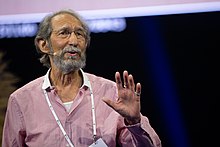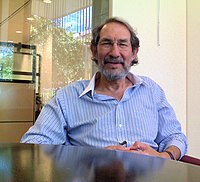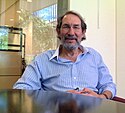Geoffrey West
Geoffrey West (ur. w 1940 r. w Taunton, Somerset) – brytyjski fizyk.
Życiorys
W wieku 13 lat przeniósł się do Londynu. W 1961 r. uzyskał tytuł magistra fizyki na Uniwersytecie Cambridge, a następnie kontynuował studia w Stanford w Kalifornii, gdzie w 1966 r. uzyskał tytuł dr (Ph.D.). Ostatecznie został członkiem wydziału, zanim przystąpił do grupy teorii cząstki w Los Alamos National Laboratory, w Nowym Meksyku. W końcu stanął na czele Instytutu Santa Fe, gdzie pracuje nad problemami związanymi z biologią. Członek Amerykańskiego Towarzystwa Fizycznego. Autor kilku książek i wydawca "Komentarzy do Biologii Teoretycznej" (Comments in Theoretical Biology). Został uhonorowany przez tygodnik Time, w kategorii "Time 100" - "Ludzie, którzy kształtują nasz świat"[1].
Wraz z Jimem Brownem i Brianem Enquistem prostą formułą matematyczną wyraził korelację pomiędzy rozmiarami organizmu a przeciętnym okresem jego życia. Przede wszystkim czas życia związany jest ściśle z częstotliwością pulsu. Każde obdarzone sercem zwierzę ma przez całe życie do dyspozycji mniej więcej tę samą liczbę uderzeń serca - około jednego miliarda. Puls małych zwierząt jest jednak znacznie szybszy niż zwierząt dużych. Okazuje się, że szybkość bicia serca różnych organizmów daje się wyrazić jako stosunek ich mas podniesiony do potęgi minus 1/4. Na przykład kot, który jest około 100 razy masywniejszy od myszy, ma puls wolniejszy od niej o czwarty pierwiastek ze 100 - czyli około 3,2 razy. Żyje też ok. trzy razy dłużej.
Przypisy
- ↑ Artykuł w Time o Geoffreyu West, 30 kwietnia 2006. time.com. [zarchiwizowane z tego adresu (2009-05-27)]. (ang.)
Bibliografia
- "Wiedza i życie". archiwum.wiz.pl. [zarchiwizowane z tego adresu (2019-08-26)].
- Geoffrey West, physicscentral.com. physicscentral.com. [zarchiwizowane z tego adresu (2007-07-02)]. (ang.) - sylwetka
- Edwin Cartlidge "Yeah, but what about the crayfish?" physicworld.com 01-07-2001 (ang.)
Media użyte na tej stronie
Autor: Augustas Didžgalvis, Licencja: CC BY-SA 4.0
Fizikas-teoretikas Geoffrey West
Autor: Steve Jurvetson from Menlo Park, USA, Licencja: CC BY 2.0
Geoffrey West, President of the Santa Fe Institute.
"As animals get bigger, from tiny shrew to huge blue whale, pulse rates slow down and life spans stretch out longer, conspiring so that the number of heartbeats during an average stay on Earth tends to be roughly the same, around a billion. A mouse just uses them up more quickly than an elephant."
<a href="https://www.flickr.com/photos/jurvetson/45848665">More biological thoughts</a> from Geoffrey West, President of the Santa Fe Institute.
He recently extended his scaling law analyses from the organism to societies, finding economy of scale analogies in the phenomena of cities. But unlike biology, the exponent is greater than one, implying accelerating growth.
“Cities are where ideas are born… and that is a far more powerful growth stimulant than economies of scale. The presence of qualified professions and entrepreneurs constitutes a reason for a place to grow. If you can create a place that is exciting intellectually, that tends to attract more people. The findings are surprising because they suggest that cities follow growth trajectories that have no biological counterpart. This year, for the first time, more people will live in cities than in rural areas, according to UN projections. At this tipping point in human history, it is worth trying to understand the mechanisms behind urbanisation and where it is headed.” (From <a href="https://www.newscientist.com/channel/being-human/mg19426051.400-ideas-the-lifeblood-of-cities.html">New Scientist</a>)
“While most of us imagine idyllic rural America as the epitome of sustainable living, conventional wisdom is exactly backward. Cities are bastions of environmentalism. People who live in densely populated places lead environmentally friendly lives. They consume fewer resources per person and take up less space. And because efficiency scales with the size of the population, big cities are always more efficient than small cities. Bottom line: The secret to creating a more environmentally sustainable society is making our big cities bigger. We need more metropolises. The researchers also found that as cities got bigger, each individual got more productive. A doubling of population led to a more than doubling of creative and economic output.” (excerpts from <a href="http://www.ceosforcities.org/conversations/blog/2007/07/the_living_city.php">Seed</a>, Aug 2007)
(I wanted to test the little camera on my new crackberry, so it was a spontaneous moment...)


